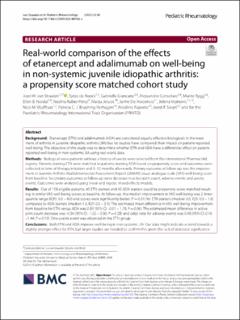| dc.contributor.author | van Straalen, Joeri W. | |
| dc.contributor.author | de Roock, Sytze | |
| dc.contributor.author | Giancane, Gabriella | |
| dc.contributor.author | Consolaro, Alessandro | |
| dc.contributor.author | Rygg, Marite | |
| dc.contributor.author | Nordal, Ellen Berit | |
| dc.contributor.author | Rubio-Pérez, Nadina | |
| dc.contributor.author | Jelusic, Marija | |
| dc.contributor.author | De Inocencio, Jaime | |
| dc.contributor.author | Vojinovic, Jelena | |
| dc.contributor.author | Wulffraat, Nico M. | |
| dc.contributor.author | Bruijning-Verhagen, Patricia C. J. | |
| dc.contributor.author | Ruperto, Nicolino | |
| dc.contributor.author | Swart, Joost F. | |
| dc.date.accessioned | 2022-12-22T08:47:31Z | |
| dc.date.available | 2022-12-22T08:47:31Z | |
| dc.date.created | 2022-12-05T13:50:50Z | |
| dc.date.issued | 2022 | |
| dc.identifier.citation | Pediatric Rheumatology. 2022, 20 (1), . | en_US |
| dc.identifier.issn | 1546-0096 | |
| dc.identifier.uri | https://hdl.handle.net/11250/3039171 | |
| dc.description.abstract | Background
Etanercept (ETN) and adalimumab (ADA) are considered equally effective biologicals in the treatment of arthritis in juvenile idiopathic arthritis (JIA) but no studies have compared their impact on patient-reported well-being. The objective of this study was to determine whether ETN and ADA have a differential effect on patient-reported well-being in non-systemic JIA using real-world data.
Methods
Biological-naive patients without a history of uveitis were selected from the international Pharmachild registry. Patients starting ETN were matched to patients starting ADA based on propensity score and outcomes were collected at time of therapy initiation and 3–12 months afterwards. Primary outcome at follow-up was the improvement in Juvenile Arthritis Multidimensional Assessment Report (JAMAR) visual analogue scale (VAS) well-being score from baseline. Secondary outcomes at follow-up were decrease in active joint count, adverse events and uveitis events. Outcomes were analyzed using linear and logistic mixed effects models.
Results
Out of 158 eligible patients, 45 ETN starters and 45 ADA starters could be propensity score matched resulting in similar VAS well-being scores at baseline. At follow-up, the median improvement in VAS well-being was 2 (interquartile range (IQR): 0.0 – 4.0) and scores were significantly better (P = 0.01) for ETN starters (median 0.0, IQR: 0.0 – 1.0) compared to ADA starters (median 1.0, IQR: 0.0 – 3.5). The estimated mean difference in VAS well-being improvement from baseline for ETN versus ADA was 0.89 (95% CI: -0.01 – 1.78; P = 0.06). The estimated mean difference in active joint count decrease was -0.36 (95% CI: -1.02 – 0.30; P = 0.28) and odds ratio for adverse events was 0.48 (95% CI: 0.16 –1.44; P = 0.19). One uveitis event was observed in the ETN group.
Conclusions
Both ETN and ADA improve well-being in non-systemic JIA. Our data might indicate a trend towards a slightly stronger effect for ETN, but larger studies are needed to confirm this given the lack of statistical significance. | en_US |
| dc.language.iso | eng | en_US |
| dc.publisher | BMC | en_US |
| dc.rights | Navngivelse 4.0 Internasjonal | * |
| dc.rights.uri | http://creativecommons.org/licenses/by/4.0/deed.no | * |
| dc.title | Real-world comparison of the effects of etanercept and adalimumab on well-being in non-systemic juvenile idiopathic arthritis: a propensity score matched cohort study | en_US |
| dc.title.alternative | Real-world comparison of the effects of etanercept and adalimumab on well-being in non-systemic juvenile idiopathic arthritis: a propensity score matched cohort study | en_US |
| dc.type | Peer reviewed | en_US |
| dc.type | Journal article | en_US |
| dc.description.version | publishedVersion | en_US |
| dc.source.pagenumber | 0 | en_US |
| dc.source.volume | 20 | en_US |
| dc.source.journal | Pediatric Rheumatology | en_US |
| dc.source.issue | 1 | en_US |
| dc.identifier.doi | 10.1186/s12969-022-00763-x | |
| dc.identifier.cristin | 2088800 | |
| cristin.ispublished | true | |
| cristin.fulltext | original | |
| cristin.qualitycode | 1 | |

